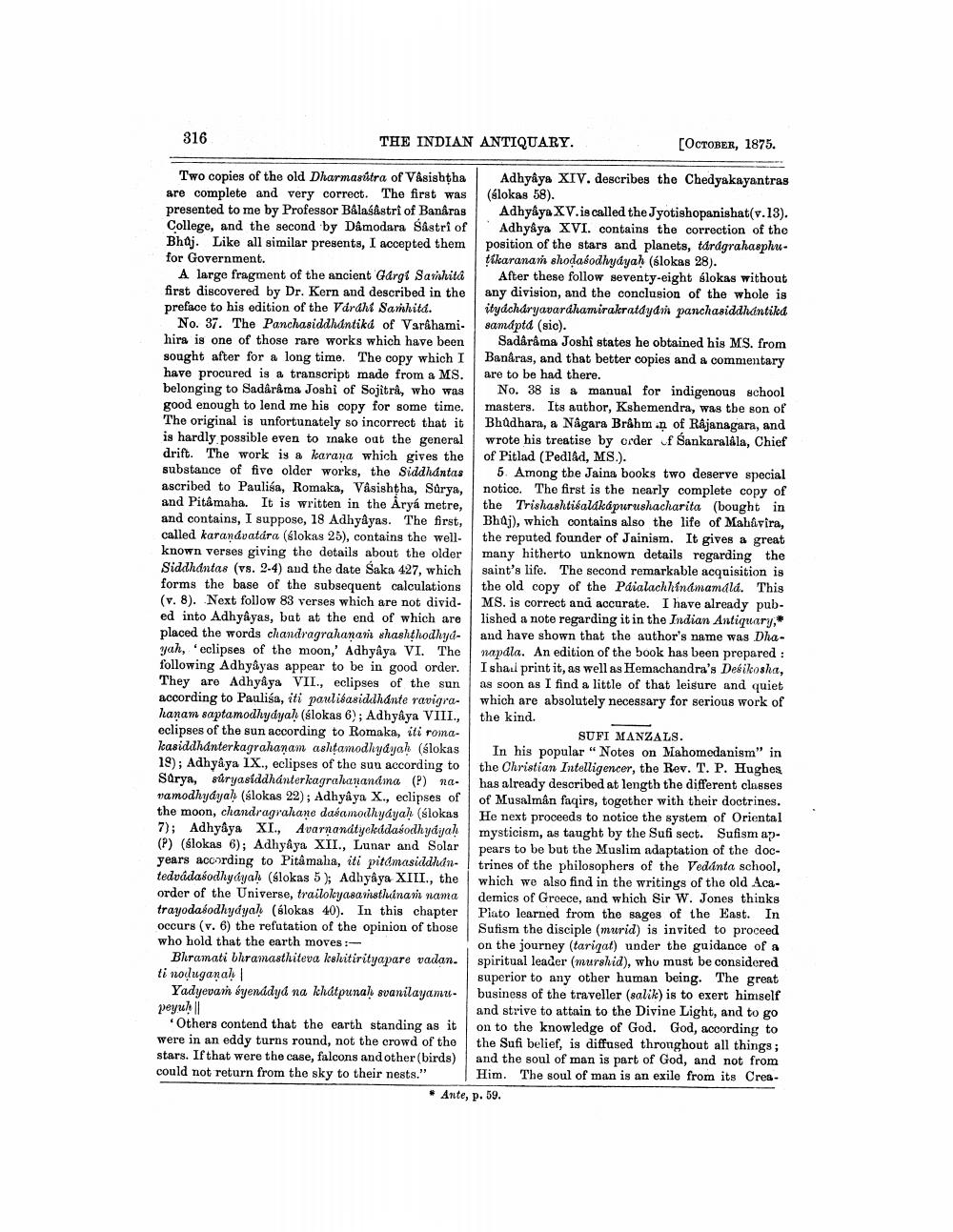________________
816
THE INDIAN ANTIQUARY.
[OCTOBER, 1875.
Two copies of the old Dharmasútra of V&sishtha Adhyâya XIV. describes the Chedyakayantras are complete and very correct. The first was (blokas 58). presented to me by Professor BÅlaśkstri of Banaras Adhyâya XV.is called the Jyotishopanishat(v.13). College, and the second by Damodara Sastri of Adhyâya XVI. contains the correction of the Bhaj. Like all similar presents, I accepted them position of the stars and planets, tardgrahasphufor Government.
tikaranaṁ shoda odhydyah (slokas 28). A large fragment of the ancient Gargi Samhita After these follow seventy-eight slokas without first discovered by Dr. Kern and described in the any division, and the conclusion of the whole is preface to his edition of the Várdhi Samhitd. itydcharyavardhamirakratdydi panchasiddhantiled
No. 37. The Panchasiddhantika of Varahami. samápta (sic). hira is one of those rare works which have been Sadârâma Joshi states he obtained his MS. from sought after for a long time. The copy which I Banaras, and that better copies and a commentary have procured is a transcript made from a MS. are to be had there. belonging to Sadarama Joshi of Sojitra, who was No. 38 is manual for indigenous school good enough to lend me his copy for some time. masters. Its author, Kshemendra, was the son of The original is unfortunately so incorrect that it Bhadhara, a Nagara Brahmin of Rajanagara, and is hardly possible even to inake out the general wrote his treatise by order of Sankaralála, Chief drift. The work is a karana which gives the of Pitlad (Pediad, MS.). substance of five older works, the Siddhantas 5. Among the Jaina books two deserve special ascribed to Paulisa, Romaka, Vâsishtha, Sarya, notice. The first is the nearly complete copy of and Pitamaha. It is written in the Aryá metre, the Trishashtiếaldkápurushacharita (bought in and contains, I suppose, 18 Adhyâyas. The first, Bhaj), which contains also the life of Mahavira, called karandvatára (slokas 25), contains the well- the reputed founder of Jainism. It gives a great known verses giving the details about the older many hitherto unknown details regarding the Siddhantas (vs. 2.4) and the date Saka 427, which saint's life. The second remarkable acquisition is forms the base of the subsequent calculations the old copy of the Paialachhinamamdld. This (v. 8). Next follow 83 verses which are not divid- MS. is correct and accurate. I have already pub. ed into Adhyâyas, but at the end of which are lished a note regarding it in the Indian Antiquary, placed the words chandragrahanan shashthodhyd- and have shown that the author's name was Dhayah, 'eclipses of the moon,' Adhyâya VI. The napdla. An edition of the book has been prepared : following Adhyâyas appear to be in good order. Ishal print it, as well as Hemachandra's Desikosha, They are Adhyâya VII., eclipses of the sun as soon as I find a little of that leisure and quiet according to Paulisa, iti pauliéasiddhante ravigra- which are absolutely necessary for serious work of hanam saptamodhydyah (slokas 6); Adhyâya VIII., the kind. eclipses of the sun according to Romaka, ili roma.
SUFI MANZALS. leasiddhanterkagrahanam ashtamodlydyal (Slokas In his popular “Notes on Mahomedanism" in 19); Adhyâya IX., eclipses of the sun according to the Christian Intelligencer, the Rev. T. P. Hughes Sarya, súryasiddhanterkagralanandma (P) na. has already described at length the different classes namodhydyah (slokas 22); Adhyâya X., eclipses of of Musalman faqirs, together with their doctrines. the moon, chandragrahan dasamodhyayah (slokas He next proceeds to notice the system of Oriental 7); Adhyâya XI., Avarnandtyekidasodhyayah mysticism, as taught by the Sufi sect. Sufism ap(?) (slokas 6); Adhyâya XII., Lunar and Solar pears to be but the Muslim adaptation of the docyears according to Pitâ maha, iti pitámasiddhdn- trines of the philosophers of the Vedanta school, tedvádasodhyayak (slokas 5); Adhyâya XIII., the which we also find in the writings of the old Acaorder of the Universe, trailokyasamstlinari nama demics of Greece, and which Sir W. Jones thinks trayodabodhyayah (slokas 40). In this chapter Piato learned from the sages of the East. In occurs (v. 6) the refutation of the opinion of those Sufism the disciple (murid) is invited to proceed who hold that the earth moves :
on the journey (tarigat) under the guidance of a Bhramati bhramasthiteva kshitirityapare vadan. spiritual leader (murshid), who must be considered ti noluganal
superior to any other human being. The great Yadyevam éyenddyd na khátpunah svanilayanır. business of the traveller (salik) is to exert himself peyul |
and strive to attain to the Divine Light, and to go Others contend that the earth standing as it on to the knowledge of God. God, according to were in an eddy turns round, not the crowd of the the Sufi belief, is diffused thronghout all things; stars. If that were the case, falcons and other (birds) and the soul of man is part of God, and not from could not return from the sky to their nests." Him. The soul of man is an exile from its Cree
* Ante, p. 59.




